PEARLS PAST AND PRESENT
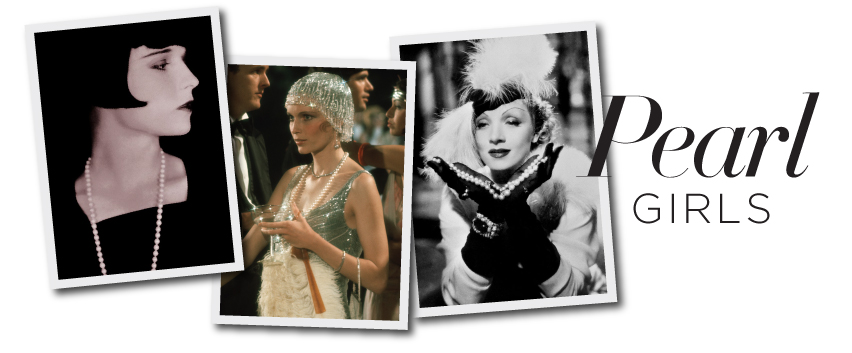
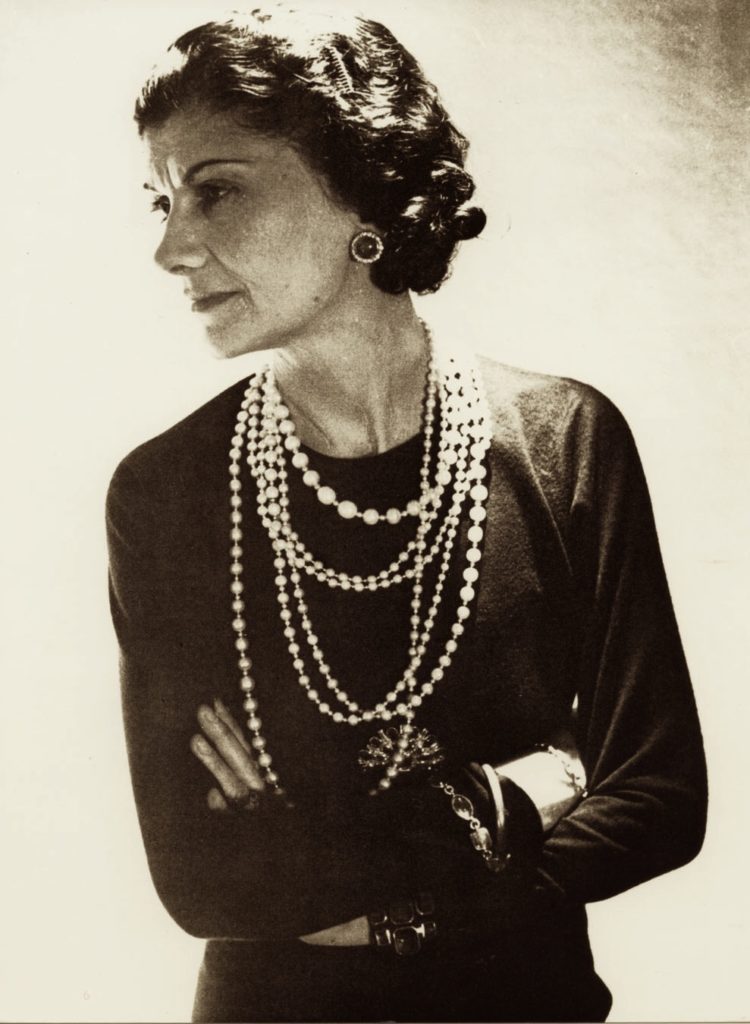
With our preview of the new book The Pearl Necklace (Assouline; release date: October 2016), our article on Danish designer Lene Vibes’ magical approach to pearls and our profile on LA-based designer Hisano’s organic boho-style geode and gemstone pearls, we thought it fitting to pay homage to favorite stories of iconic pearls and stylish Pearl Girls throughout history.
Every collector has her own tale to tell about pearls, whether they are of famous provenance, passed down through generations, or given as tokens of loveand affection. Queens, princesses, famous designers, socialites and film stars all recognized the power of pearls, a classic luster that shone throughout history.
Prior to the 20th century, when all women began to wear pearls, due in part to Mikimoto’s invention of the cultured pearl and their desire to imitate their favorite celebrities of the day, pearls were one of the favored gems of the aristocracy. Elizabeth I, Catherine the Great, Marie Antoinette, Queen Alexandra and Empress Josephine all had a penchant for pearls. Portraits of Queen Elizabeth I feature a plethora of pearls sewn into her gowns and wig, and strands upon strands cascading down the front of her high-neckline gowns. 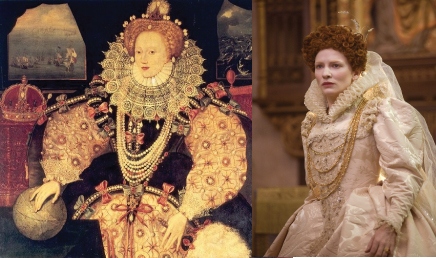
When we think of Coco Chanel, we get an instant image of a designer who changed perceptions of personal style—wearing pearls. Long strands draped across her shoulders and dangling down her back, or mixed in with an assortment of chains, pearls were part of Chanel’s armor.She once proclaimed: “A woman needs ropes and ropes of pearls.”The intermingling of real and faux gave her a look that was more chic and creative than flashy or showy.
Nothing about her own style or the jewelry or clothes she designed was traditional. It was all a play on convention, from freeing women of bodices
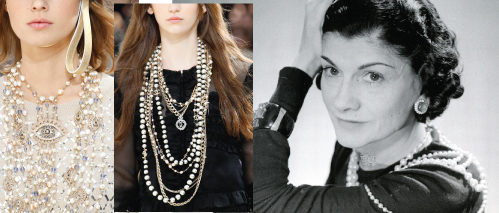 and corsets to inventing casual dress. Throughout the ‘20s she wore ‘ropes and ropes’ of faux pearls with a strand or two of real, mixed in haphazardly with costume and fine gold chains. Chanel’s first pearl necklace was a gift from her lover and lifelong influence, English polo player and businessman ‘Boy’ Capel. Coco once complained that she had never received flowers or jewelry from him. The next day he sent flowers every hour. And the following day, in jest, he asked Cartier to deliver a jewel of a tiara. The tiara was said to be promptly exchanged by Chanel for a more practical strand ofpearls. Although Coco Chanel never married, she had notorious love affairs. Russia’s Grand Duke Dmitri gave her a strand of historic Romanov pearls. Chanel bequeathed a memento of friendship and respect to Diana Vreeland, another of the world’s style arbiters who also had a penchant for pearls: a black velvet bag containing the natural pearl earrings that the designer always wore.
and corsets to inventing casual dress. Throughout the ‘20s she wore ‘ropes and ropes’ of faux pearls with a strand or two of real, mixed in haphazardly with costume and fine gold chains. Chanel’s first pearl necklace was a gift from her lover and lifelong influence, English polo player and businessman ‘Boy’ Capel. Coco once complained that she had never received flowers or jewelry from him. The next day he sent flowers every hour. And the following day, in jest, he asked Cartier to deliver a jewel of a tiara. The tiara was said to be promptly exchanged by Chanel for a more practical strand ofpearls. Although Coco Chanel never married, she had notorious love affairs. Russia’s Grand Duke Dmitri gave her a strand of historic Romanov pearls. Chanel bequeathed a memento of friendship and respect to Diana Vreeland, another of the world’s style arbiters who also had a penchant for pearls: a black velvet bag containing the natural pearl earrings that the designer always wore.
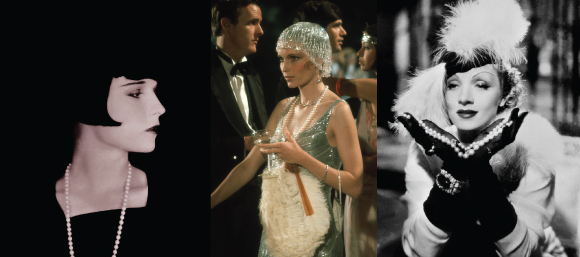 Louis Cartier’s lover and head of his jewelry department was another pearl girl. Jeanne Toussaint, whom Cartier nicknamed La panthère, was a barometer of style.She would wear as many as five long strands of pearls at a time, and either display them long or modified with thestrands clipped on her favorite brooch to create a choker-like effect that left a cascade of pearls to fall over one shoulder for an incredibly chic, signature look.
Louis Cartier’s lover and head of his jewelry department was another pearl girl. Jeanne Toussaint, whom Cartier nicknamed La panthère, was a barometer of style.She would wear as many as five long strands of pearls at a time, and either display them long or modified with thestrands clipped on her favorite brooch to create a choker-like effect that left a cascade of pearls to fall over one shoulder for an incredibly chic, signature look.
While The Duchess of Windsor was known for her sentimental jewelry, her large emeralds, her love of sapphires and the famous ‘McLean’ diamond, she often was photographed wearing natural pearls. After Edward’s abdication, Queen Mary gave her son a string of 28 graduated natural pearls with a diamond clasp, whichbecame part of Wallis’s lifelong collection. In 1950, Cartier made the Duchess a natural pearl pendant, and in 1964, the Duke added a strand of 29 cultured pearls. All of the pearl pieces went up for auction at Sotheby’s in 1987, which helpedraise $50 million for Paris’s Institut Pasteur, a pioneer in HIV/AIDs research. CalvinKlein bought two pearl strands as well as the detachable pearl drop pendant at thesale for his then-wife Kelly, who wore them to stunning effect for Vogue, and in herown style—with jeans.
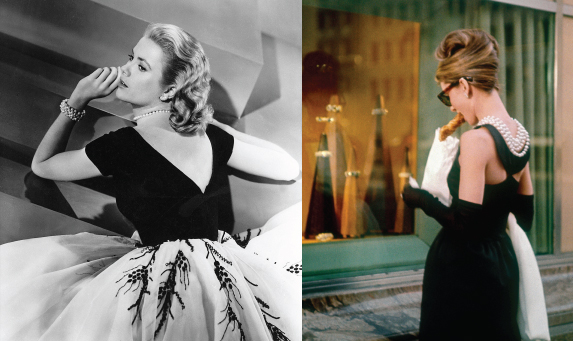 Grace Kelly became a poster girl for pearls in the 1950s. “I favor pearls on screen and in my private life,” she once said. In her film roles Kelly was known for her poise, minimal makeup, sleek blonde hair, porcelain complexion, and a preference for the understatedin fashion and jewels. Lustrous pearls reflected Kelly’s own luminescence. Starring opposite James Stewartin the Hitchcock film Rear Window (1954), her jewelry consisted mainly of pearls.In the official engagement photo of Kelly and Prince Rainier III, she wears a two-strandpearl choker. On her wedding day she selected simple pearl and diamond earringsto complement her intricate lace gown. As a wedding gift, Rainier commissioned a parure of pearls from Van Cleef & Arpels. Soon after, Van Cleef & Arpels became the jewelers to the Principality of Monaco. Princess Grace’s Van Cleef & Arpels pearl wedding suite consisted of a perfect pearl necklace, a floral-motif ring with a center pearl, a triple-strand bracelet, and a pairof ear clips.
Grace Kelly became a poster girl for pearls in the 1950s. “I favor pearls on screen and in my private life,” she once said. In her film roles Kelly was known for her poise, minimal makeup, sleek blonde hair, porcelain complexion, and a preference for the understatedin fashion and jewels. Lustrous pearls reflected Kelly’s own luminescence. Starring opposite James Stewartin the Hitchcock film Rear Window (1954), her jewelry consisted mainly of pearls.In the official engagement photo of Kelly and Prince Rainier III, she wears a two-strandpearl choker. On her wedding day she selected simple pearl and diamond earringsto complement her intricate lace gown. As a wedding gift, Rainier commissioned a parure of pearls from Van Cleef & Arpels. Soon after, Van Cleef & Arpels became the jewelers to the Principality of Monaco. Princess Grace’s Van Cleef & Arpels pearl wedding suite consisted of a perfect pearl necklace, a floral-motif ring with a center pearl, a triple-strand bracelet, and a pairof ear clips.
Jacqueline Kennedy lived by the adage that ‘pearls are always appropriate’. When John F. Kennedy became the 35th president of the United States in 1960, alleyes were on the beautiful couple who represented grace, style and a ‘new America’. As John Fairchild commented in The Fashionable Savages, ‘For the first time America had a first lady setting the taste of the land.’ Before then, women had looked to Hollywood stars and European royalty to emulate. Now American women had a cultured role model with a taste for luxury who represented their dreamsand aspirations. She seemed to echo what fashion in the early ‘60s was all about—less fitted and formal the ‘50s—yet still pulled together and chic. Pearls were part of Jackie Kennedy’s uniform; she tucked pearl necklaces into dresses and suits for day and the sleek gowns she wore in the evening. Her triple-strand, faux pearl necklace designed by American jeweler Kenneth Jay Lane became her signature piece during her time in the White House. She wore all types and strand lengths of pearls, depending on the occasion,and sometimes added a brooch to the top of a neckline, which looked as if it was a clasp or pendant attached to the pearls. Many did not know at the time that several of her pearls were imitations. One of the most famous pearl necklaces that Sotheby’s sold was fake. The hammer went down at $200,000 for the original three-strand necklace, which she had bought from Kenneth Jay Lane for less than $200.
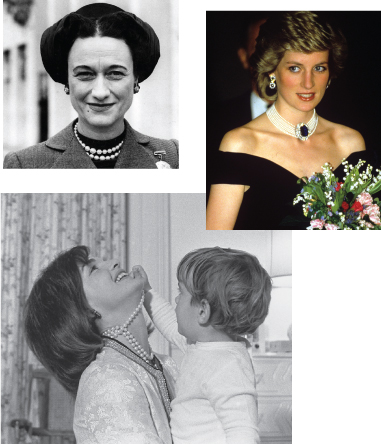 Royalty reigned over pearls once again in England in 1981 when Lady Dianamarried Prince Charles. As a wedding gift, Queen Elizabeth gave Diana a tiara called the‘Cambridge Lover’s Knot’, a very heavy headpiece with 19 perfect swingingpearl drops, created for Queen Mary by Garrard in 1914. Pearls were Diana’s favorite gems. Her first single strand of pearls, which had a sapphire clasp, was a gift from her parents, which she wore throughout her life.The most stunning of Diana’s chokers was one of seven strands with a large, double row of diamonds surrounding an oval sapphire. The gem was originally part ofthe brooch that was her wedding gift from the Queen Mother. She later mounted thesapphire as the centerpiece and, since she was photographed almost every time she wore it, started a trend that swept across Europe and the U.S. Another of her looks was to wear two twisted rows of pearls with a pearl-cluster clasp. Like Jacqueline Kennedy, she went to Kenneth Jay Lane for a faux sapphire and double-strand piece as well as the pearl necklace that she knotted quite alluringly down the back of a low-cut dress. Diana grew into her style, as most women do, as she grew more into herself.
Royalty reigned over pearls once again in England in 1981 when Lady Dianamarried Prince Charles. As a wedding gift, Queen Elizabeth gave Diana a tiara called the‘Cambridge Lover’s Knot’, a very heavy headpiece with 19 perfect swingingpearl drops, created for Queen Mary by Garrard in 1914. Pearls were Diana’s favorite gems. Her first single strand of pearls, which had a sapphire clasp, was a gift from her parents, which she wore throughout her life.The most stunning of Diana’s chokers was one of seven strands with a large, double row of diamonds surrounding an oval sapphire. The gem was originally part ofthe brooch that was her wedding gift from the Queen Mother. She later mounted thesapphire as the centerpiece and, since she was photographed almost every time she wore it, started a trend that swept across Europe and the U.S. Another of her looks was to wear two twisted rows of pearls with a pearl-cluster clasp. Like Jacqueline Kennedy, she went to Kenneth Jay Lane for a faux sapphire and double-strand piece as well as the pearl necklace that she knotted quite alluringly down the back of a low-cut dress. Diana grew into her style, as most women do, as she grew more into herself.
Of all the natural pearls in the world the most famous is ‘La Peregrina’, which means ‘pilgrim’ or ‘wanderer,’ an apt name for a pearl that traveled for more than 400 years until it found its perfect place in history around Elizabeth Taylor’s neck.
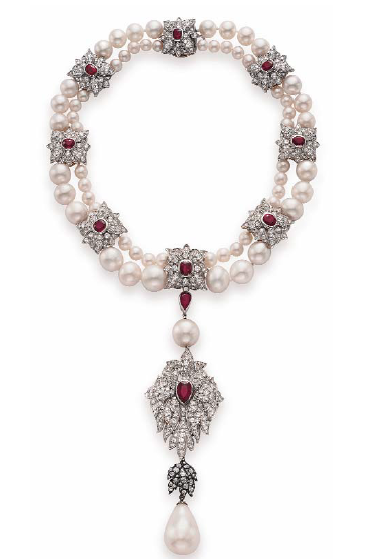 In 1969, Richard Burton paid $37,000 at auction for the 55.6-carat beautiful pear-shaped pearl, which he bought as a present for Elizabeth Taylor’s 37th birthday. At the time, the pearl hung from a delicate chain of platinum interspersed with tiny pearls and it came with a booklet detailing the pearl’s provenance and ‘family tree’, and a list of the people who had owned it, including a 16th-century slave who won his freedom by bringing the pearl to the Spanish court, Queen Margarita and Queen Isabella of Spain, and Mary Tudor of England. In the 1800s it was owned by the Bonaparte family.
In 1969, Richard Burton paid $37,000 at auction for the 55.6-carat beautiful pear-shaped pearl, which he bought as a present for Elizabeth Taylor’s 37th birthday. At the time, the pearl hung from a delicate chain of platinum interspersed with tiny pearls and it came with a booklet detailing the pearl’s provenance and ‘family tree’, and a list of the people who had owned it, including a 16th-century slave who won his freedom by bringing the pearl to the Spanish court, Queen Margarita and Queen Isabella of Spain, and Mary Tudor of England. In the 1800s it was owned by the Bonaparte family.
Taylor was so excited by her gift that she kept touching it like a talisman. But at one point she reached down to find the pearl was no longer there. It turns out it was in her dog’s mouth.
A gem that had survived wars and famine, now was a plaything for a dog. But it suffered only a couple of minor scratches.
Three years after acquiring La Peregrina, Taylor approached Cartier to have it made into a necklace based on a choker design she had seen in a portrait of Mary Tudor, Queen of England. Taylor worked with Cartier designer Al Durante on the piece comprising Oriental pearls, intersected with diamond and ruby quatrefoils, set in platinum and gold. When Taylor’s jewels wentup for auction at Christie’s in December 2011, the Peregrina necklace sold for a record$11.8 million.
We saw pearls go from screen to street (or more directly to design studios and manufacturers around the globe) after Renee Russo wore a necklace of stationed pearls on silk thread, designed by Wendy Brigode, in the films Tin Cup and Ransom. It was a sleeper jewel that made millions for all that copied the look.
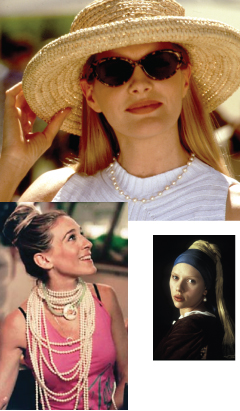 The Girl with The Pearl Earring also brought back baroque pearl drop earrings in all variations, price ranges and colors of pearls, proving how film can affect what women relate to and purchase.
The Girl with The Pearl Earring also brought back baroque pearl drop earrings in all variations, price ranges and colors of pearls, proving how film can affect what women relate to and purchase.
Pearls that have been handed down like heirlooms throughout generations string together our personal and cultural histories.
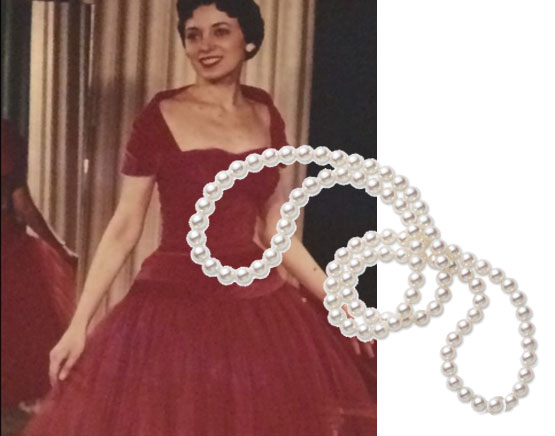 My own story takes place in the mid ‘60s, when at 5 years old, I would prop myself up on my mother’s vanity and help her get ready for a night out with my dad. She owned two strands of Mikimoto pearls—one choker and the other opera length. A cross between Elizabeth Taylor and Audrey Hepburn, my mom, a one time runway model, who was studying to be an actress before marrying my dad—took on the look of the day—shift dresses and smart suits accessorized by pearls a la Jackie Kennedy. Whichever strand she was not wearing—I would wrap around my neck in an attempt to imitate the woman I so wanted to grow up to be. In the make love not war time of late ‘60s/early ‘70s, she tucked them away in favor of wearing love beads layered with peace sign pendants. In the ‘80s it was all about Robert Lee Morris’ sculptural collars. When my mom passed away in the early ‘90s unexpectedly at 55, I was given the strands of pearls. When I clasp them on, I imagine myself as a young girl, so wanting to emulate the woman looking back at me in her mirror. And I imagine her standing next to me once again and hope that I turned into the women she would have wanted me to become.
My own story takes place in the mid ‘60s, when at 5 years old, I would prop myself up on my mother’s vanity and help her get ready for a night out with my dad. She owned two strands of Mikimoto pearls—one choker and the other opera length. A cross between Elizabeth Taylor and Audrey Hepburn, my mom, a one time runway model, who was studying to be an actress before marrying my dad—took on the look of the day—shift dresses and smart suits accessorized by pearls a la Jackie Kennedy. Whichever strand she was not wearing—I would wrap around my neck in an attempt to imitate the woman I so wanted to grow up to be. In the make love not war time of late ‘60s/early ‘70s, she tucked them away in favor of wearing love beads layered with peace sign pendants. In the ‘80s it was all about Robert Lee Morris’ sculptural collars. When my mom passed away in the early ‘90s unexpectedly at 55, I was given the strands of pearls. When I clasp them on, I imagine myself as a young girl, so wanting to emulate the woman looking back at me in her mirror. And I imagine her standing next to me once again and hope that I turned into the women she would have wanted me to become.
Photo credits: From Top to Bottom, left to right:
Coco Chanel, /Pictorial Press Ltd/ Alamy Stock Photo Portrait of Queen Elizabeth I. Cate Blanchett In Elizabeth: The Golden Age ,2007, Universal/Studio Canal/Working Title / Sparham, Laurie/ The Kobal Collection at Art Resource NY. Photos courtesy of Chanel 2016 Fall Runway Show. Coco Chanel, Pictorial Press Ltd. / Alamy Stock Photo. Louise Brooks, 1935, World History Archive / Alamy Stock Photo, 1935. Mia Farrow in The Great Gatsby, 1974, Paramount / The Kobal Collection at Art Resource NY.Marlene Dietrich in Desire , 1936, AF Archive / Alamy Stock Photo 1936. Grace Kelly in Rear Window,1954, Paramount/Bud Franker/Kobal Collection at Art Resource. Audrey Hepburn in Breakfast at Tiffanys, 1961, Paramount/The Kobal Collection at Art Resource NY. The Duchess of Windsor, 1950s, REX/Shutterstock.Princess Diana at the Rathaus, Austria, 1986, (UK) Ltd/REX/Shutterstock. First Lady Jacqueline Kennedy with John Kennedy Jr. the White House nursery in 1962/Everett Collection Historical/ Alamy Stock Photo La Peregrina pearl set as pendant on a cultured pearl, ruby, and diamond necklace by Cartier, STEWART COOK/REX/Shuttershock. Rene Russo in Tin Cup, 1996,Moviestore Collection/REX/Shutterstock. Scarlett Johansson in Girl With The Pearl Earring, 2003, Delux/Lion’s Gate/Pathe Archer Street/The Kobal Collection / Buitendijk, Jaap at Art Resource NY. Sarah Jessica Parker in Sex & The City/ My Mom/ Still life Mikimoto Pearls




